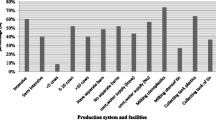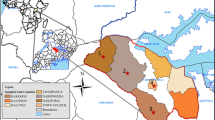Abstract
A cross-sectional study was conducted to assess the quality of raw milk and stakeholders’ awareness on milk-borne health risks and factors for poor milk hygiene in Arusha City and Meru District, Tanzania between October and December 2012. A total of 105 smallholder dairy farmers, milk vendors and milk retailers were interviewed, and milk samples were collected for physical, microbial and antibiotic residue analysis using standard procedures. Questionnaire results indicated high level of awareness (94 %) that drinking raw milk can predispose consumers to milk-borne diseases; nevertheless, 65 % of respondents consumed raw milk. Physicochemical analyses showed some of the milk had sediments (20 %), bad smell (21 %) and had clotted on alcohol test (27 %). About 36 % of milk samples had pH below 6.6, and 25 % had specific gravity below 1.028 g/ml. The mean total viable count (TVC) of milk from vendors is significantly (P < 0.05) higher than that from retailers and smallholder dairy farmers. Generally, 65 % of milk samples assessed had a higher TVC than the level recommended (2.0 × 105 cfu/ml) by the East African Community (EAC) standards. Up to 91 % of the milk samples had bacterial growth that included Eschericia coli (66 %), Staphylococcus aureus (33 %), Corynebacterium (11 %) and Pseudomonas (10 %). All smallholder dairy farmers were aware of drug residues, but majority (57 %) were unaware of human health effects caused by veterinary drug residues in milk. Up to 97 % of respondents reported to comply with drug withdrawal periods. This possibly led to all milk samples analysed to be negative from detectable levels of antibiotic residues. It is concluded that the level of awareness on milk quality is high, although practices associated with milking and post-harvest handling predispose milk to bacterial contamination which is a public health risk to milk consumers.
Similar content being viewed by others
References
EAC (East African Community), 2006. East African standard, raw cow milk specification. pp. 1–2.
Bertu, W.J., Dapar, M., Gusi, A.M., Ngulukun, S.S., Leo, S., and Jwander L.D., 2010. Prevalence of Brucella antibodies in marketed milk in Jos and environs. African Journal of Food Science, 4(2), 062–064.
Brown, H.M., 2014. Assessment of microbial quality of raw cow’s milk and antimicrobial susceptibility of selected milk-borne bacteria in Kilosa and Mvomero districts, Tanzania. Unpublished Dissertation for Award of MSc. Degree at Sokoine University of Agriculture, Morogoro, Tanzania, pp. 1–115.
Carter, G.R. and Wise, D.J., 2004. Essentials of veterinary bacteriology and mycology. Blackwell, Hoboken. 290pp.
Filimon, M.N., Borozin, A.B.., Bordean, D.M., Popescu, R., Gotia, S.R., Verdes, D., Morariu, F. and Treitli, S., 2011. Quality assessment of raw milk and pasteurized milk using microbiological parameters. Animal Science and Biotechnologies, 44, 412–416.
Hogan, S.J., Gonzalez, R.N., Harmon, J.R., Nickerson, S.C., Oliver, S.P., Pankey, J.W. and Smith, L.K., 1999. Laboratory handbook on Bovine mastitis, (National Mastitis Council, Inc., W D Hoard, Fort Atkinson, USA)
Isenberg, H.D., 1998. Essential procedures for clinical microbiology. pp. 37–167, American Society for Microbiology, Washington DC.
ISO 7218: 2007. (International Standards Organization, 2007). Microbiology of food and animal feeding stuffs- general requirements and guidance for microbiological examination. No.7218. pp. 8–15.
ISO/FDIS, 2001. Milk and milk Products – General guidance for the preparation of samples, initial suspensions and decimal dilutions for microbiological examination. International Organization for Standardization, Geneva, Switzerland. No. 8261 (E).
Kang’ethe, E.K., Arimi, S.M., Omore, A.O., McDermott, J.J., Nduhiu, J.G., Macharia, J.K. and Gitua A., 2000. The Prevalence of antibodies to Brucella abortus in marketed milk in Kenya and its public health implications. Smallholder Dairy (Research and Development) Project Research Report, 54pp.
Karimuribo, E.D., Kusiluka, L.J.M., Mdegela, R.H., Angolwisye, M., Kapaga, A.M.., Sindato, C. and Kambarage, D.M., 2005. Studies on mastitis, milk quality and health risks associated with consumption of milk from pastoral herds in Dodoma and Morogoro regions, Tanzania. Journal of Veterinary Science, 6, 213–221.
Kivaria, F.M., Noordhuizen, J.P.T.M., and Kapaga, A.M., 2006. Evaluation of the hygienic quality and associated public health hazards of raw milk marketed by smallholder dairy producers in the Dar es Salaam region, Tanzania. Tropical Animal Health Production, 38, 185–94.
Kurwijila, R.L., Mdoe, N., Nyange, D.N., Auerbock, R.M. and Malya, H.N. 1995. Assessment of fresh milk and milk products and consumption in Dar es Salaam, Report to the Austro Project Association, (Austro Project Association, Dar es Salaam), 54pp.
Kurwijila, R.L., Omore, A., Staal, S. and Mdoe, N.S.Y., 2006. Investigation of the risk of exposure to antimicrobial residue present in marketed milk in Tanzania. Journal of Food Protection, 69, 2487–2492.
Kurwijila, L.R., Omore, A. and Staal, S., 2009. Dairy sub sector development strategy, East Africa Regional initiatives in value chains. Lesson from on- going R & D initiatives in dairy value chains, rural livelihood development company. Version Board 17–04 - 2009. [www.rldc.co.tz/docs/rldcdairy ] site visited on 24/3/2012.
Mdegela, R.H., Ryoba, R., Karimuribo, E.D., Phiri, E.J., Løken, T., Reksen, O., Mtengeti, E. and Urio, N.A., 2009. Prevalence of clinical and subclinical mastitis and quality of milk in smallholder dairy farms in Tanzania. Journal of the South African Veterinary Association, 80, 163–168.
Omore, A.O., Staal, S.J., Wanyoike, F., Osafo, E.L.K., Kurwijila, L., Barton, D., Mdoe, N., Nurah, G. and Aning, G., 2009. Market mechanisms and efficiency in urban dairy products markets in Ghana and Tanzania. ILRI Research Report 19, IRIL (International Livestock Research Institute), Nairobi, Kenya, pp. 57.
Parekh, T.S., and Subhash, R., 2008. Molecular and bacteriological examination of milk from different milch animals with special reference to coliforms. Current Research in Bacteriology, 1(2), 56–63.
Quinn, P.J., Carter, M.E., Markey, B., Carter, G.R., 1994. Clinical veterinary microbiology, Mosby, London, pp. 22–91.
Schoder, D., Maichin, A., Lema, B. and Laffa, J., 2013. Microbiological quality of milk in Tanzania: from Maasai stable to African consumer table. Journal of Food Protection 76(11), 1908–1915.
Shija, F., 2013. Assessment of milk handling practices and bacterial contaminations along the dairy value chain in Lushoto and Handeni districts in Tanga region, Tanzania. Unpublished dissertation for award of MSc. degree at Sokoine University of Agriculture, Morogoro, Tanzania, pp. 1–88.
Shirima, G.M., Kazwala, R.R., and Kambarage, D.M., 2003. Prevalence of bovine tuberculosis in cattle in different farming systems in the eastern zone of Tanzania. Preventive Veterinary Medicine, 57, 167–172.
TZS (Tanzania Bureau of Standards), 2007. Microbiology of food and animal feeding stuffs-method for enumeration of microorganisms - Colony Count Technique at 30°C. Tanzania Standards Specification. No 118:2007.
Acknowledgments
The authors acknowledge the financial support from Tanzania Food and Drugs Authority. All the milk stakeholders involved in the study are thanked.
Conflict of interest
The authors declare that they have no conflict of interest.
Author information
Authors and Affiliations
Corresponding author
Rights and permissions
About this article
Cite this article
Ngasala, J.B., Nonga, H.E. & Mtambo, M.M.A. Assessment of raw milk quality and stakeholders’ awareness on milk-borne health risks in Arusha City and Meru District, Tanzania. Trop Anim Health Prod 47, 927–932 (2015). https://doi.org/10.1007/s11250-015-0810-y
Received:
Accepted:
Published:
Issue Date:
DOI: https://doi.org/10.1007/s11250-015-0810-y




